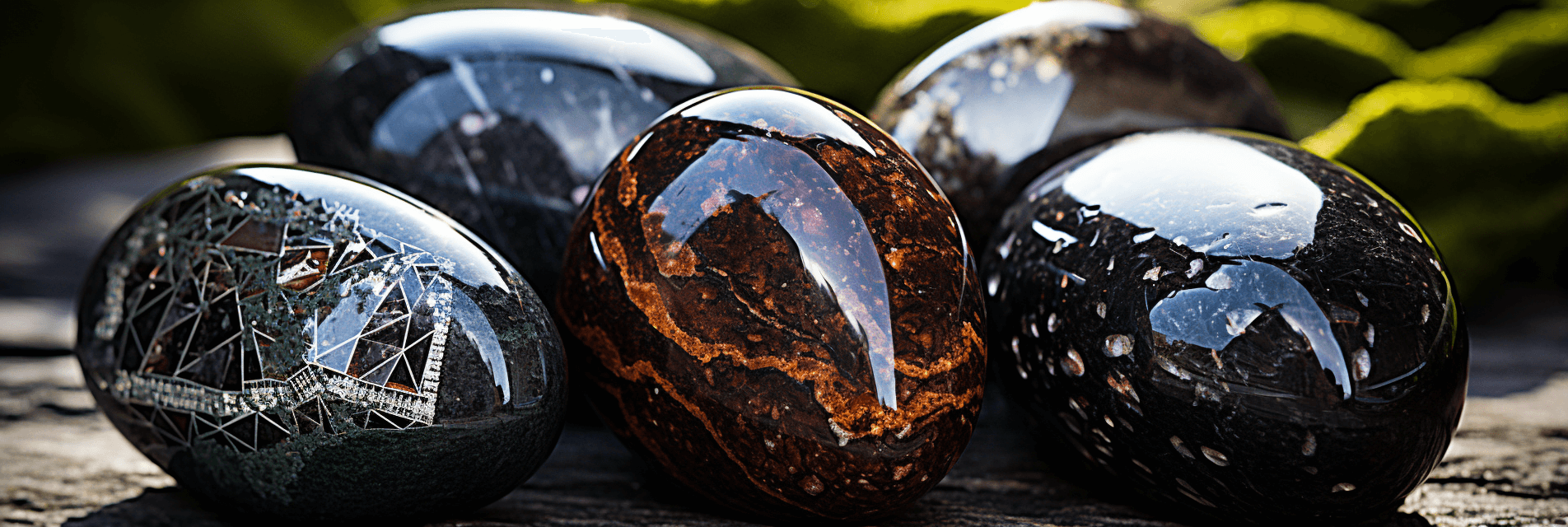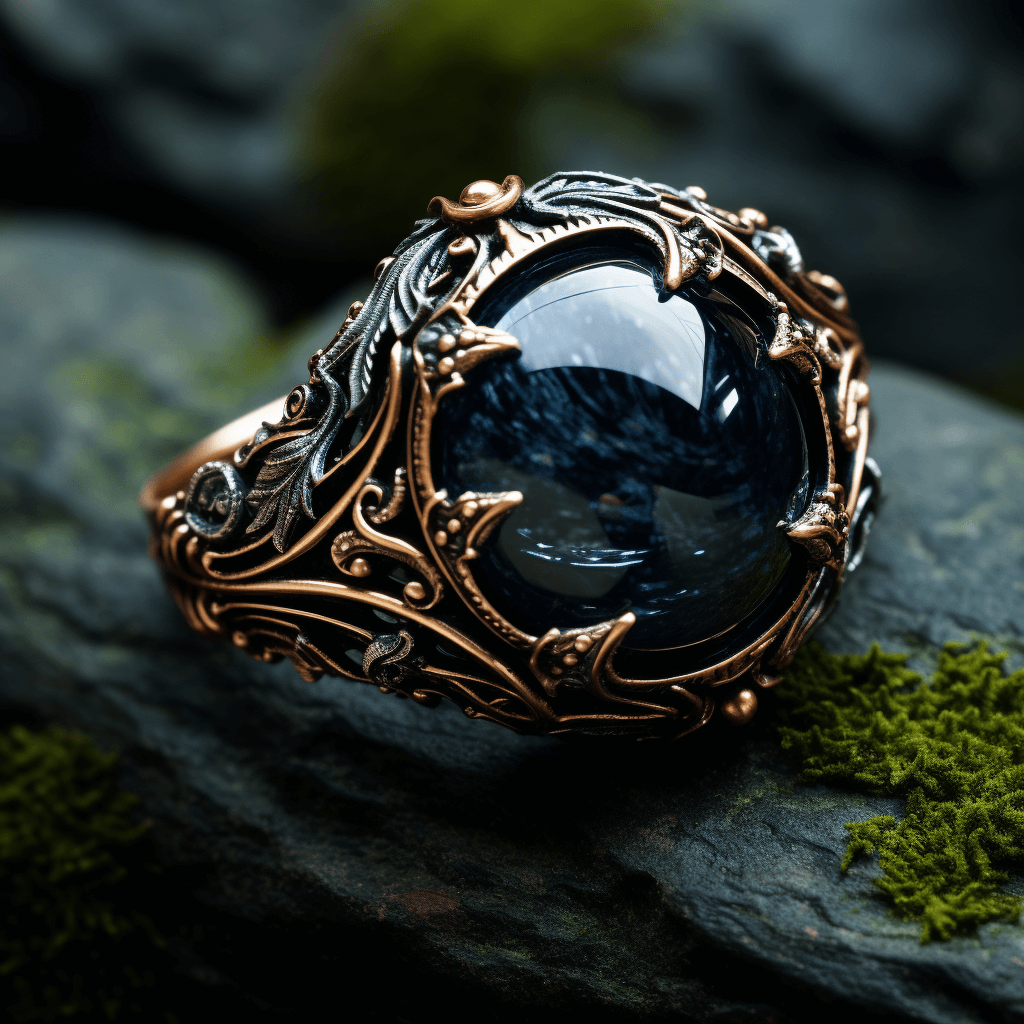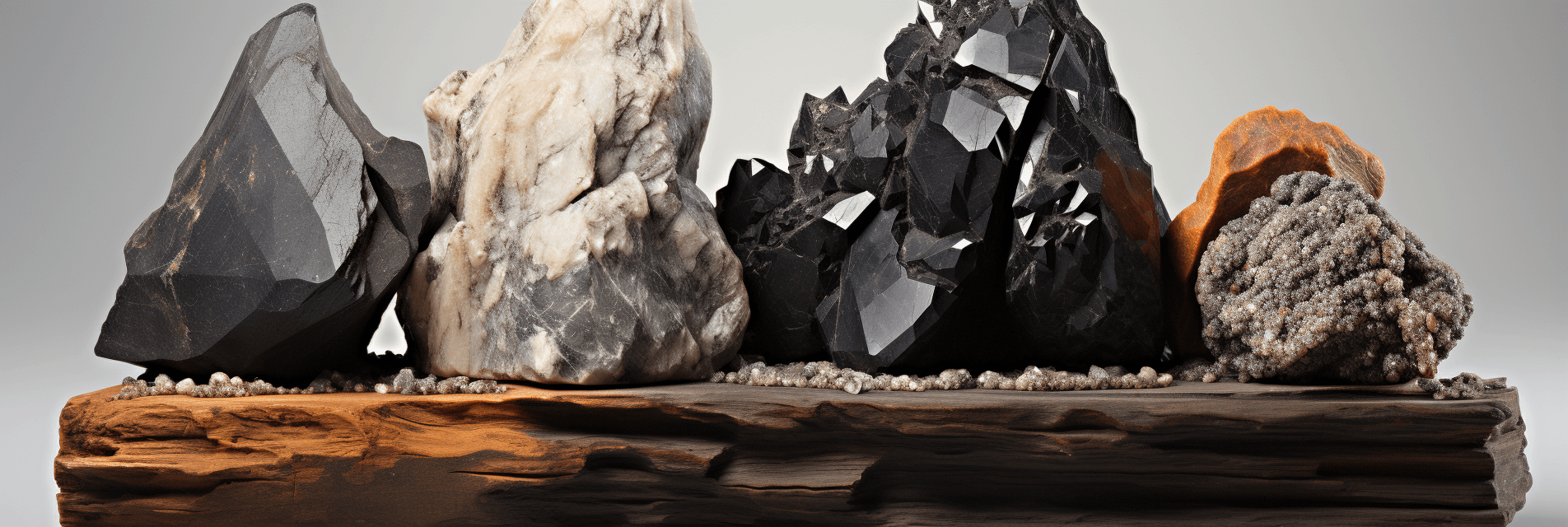Obsidian: Nature’s Volcanic Glass
Obsidian, often dubbed as nature’s volcanic glass, is a distinct and mesmerizing material born from the heart of fiery volcanoes. This naturally occurring volcanic glass is crafted when molten lava undergoes rapid cooling, preventing crystallization and resulting in a smooth, lustrous appearance. Historically celebrated for its sharp edges, obsidian was utilized in tools, weapons, and ornamental artifacts, making it an integral part of human civilization and its progression.
Such rapid transition from a liquid to a solid state, from burning heat to cold rigidity, underscores the fascinating dual nature of obsidian. While it’s aesthetically captivating, the true essence of obsidian lies in its journey — a journey from turbulent beginnings to a polished end, embodying both nature’s fury and its serenity.
From ancient tools to modern-day jewelry, obsidian’s multifaceted appeal spans across time and cultures, cementing its place as one of nature’s most enigmatic creations.
The Formation and Geological Properties of Obsidian
Obsidian’s captivating charm isn’t just skin deep. Its formation is a testament to nature’s alchemy, and its geological properties provide insights into its unique composition and characteristics.
The birth of obsidian starts deep within a volcano. When lava rich in silica experiences a rapid cooling process on the Earth’s surface, it solidifies quickly, giving no time for mineral crystals to grow. This results in the formation of a glassy rock — obsidian.
| Property | Description |
|---|---|
| Color | Typically black, but can also be brown, tan, green, blue, red, or a combination thereof. |
| Texture | Glassy and smooth, often with sharp edges when broken. |
| Composition | Mainly composed of Silicon Dioxide (70% or more). May contain small amounts of other oxides. |
| Transparency | Translucent to opaque, with some varieties showing a sheen or iridescence. |
| Fracture | Conchoidal (shell-like) fracture, which is why it was used for making sharp-edged tools in prehistoric times. |
| Hardness | 5 to 5.5 on the Mohs hardness scale. |
| Specific Gravity | Approximately 2.4, making it less dense than many other volcanic rocks. |
| Luster | Vitreous or glass-like. |
Each property of obsidian, from its color variations to its specific gravity, offers clues about its formation environment and the elements that played a role in its birth. Whether utilized as a gemstone, an archaeological specimen, or simply appreciated for its beauty, understanding these properties can deepen one’s appreciation for this unique volcanic treasure.
Diverse Types and Colors of Obsidian
Obsidian’s allure isn’t confined to its standard black sheen. The volcanic glass manifests in a variety of colors and types, each bearing unique patterns and shades due to different environmental conditions and impurities present during formation. From the mystical sheen of rainbow obsidian to the snowflake patterns on snowflake obsidian, each type tells a tale of its volcanic origin.

| Type | Color and Description |
|---|---|
| Black Obsidian | The most common variety, it’s characterized by its pure, glossy black appearance. |
| Rainbow Obsidian | Displays layers of iridescent colors (like rainbows) when viewed under specific lighting conditions, owing to the presence of tiny mineral crystals or inclusions. |
| Snowflake Obsidian | Black with distinct white or grey “snowflake” patterns, formed due to the crystallization of small phenocrysts of cristobalite in the glass. |
| Sheen Obsidian | Presents a golden or silvery sheen, resulting from gas bubbles reflecting light from within the stone. |
| Mahogany Obsidian | Reddish-brown streaks or patches on a black background, giving it a mahogany wood appearance. |
| Apache Tears | Translucent, rounded nodules of obsidian often found embedded within a greyish perlite matrix. |
These variations of obsidian each possess their own beauty and significance. Jewelry makers, collectors, and enthusiasts alike cherish them for their individual characteristics, making obsidian a versatile gemstone with a wide range of aesthetic appeal.
Historical to Modern Uses of Obsidian: From Ancient Tools to Contemporary Art
Obsidian, with its sharpness and beauty, has been a significant component in human culture for millennia. Its historical footprint spans from the hands of ancient toolmakers to the workshops of modern artisans.
Historical Uses
Long before it was recognized for its ornamental value, obsidian was highly prized for its practical applications:
- Stone Tools: Due to its conchoidal fracture, obsidian can be chipped into razor-sharp edges. This made it an invaluable resource for creating tools and weapons, such as arrowheads, knives, and scrapers.
- Trade: Given its rarity and the specific conditions required for its formation, obsidian became a significant trade item in many ancient cultures, its routes helping archaeologists trace connections between ancient civilizations.
- Religious and Ritualistic Significance: The reflective quality of obsidian was seen as mystical in some cultures, leading to its use in ceremonies, as mirrors for divination, and even in burial goods.
Modern Uses
In contemporary times, while the practical applications of obsidian as a tool have diminished, its cultural and artistic significance has soared:

- Jewelry: With its diverse range of colors and patterns, obsidian is fashioned into beads, pendants, rings, and other jewelry items.
- Art: Artists often utilize obsidian’s sheen and textures to craft sculptures, ornamental items, and intricate carvings.
- Wellness: In the realm of alternative healing, obsidian is believed to offer protective energies and is used in various spiritual and wellness practices.
- Surgical Scalpels: In specialized medical contexts, obsidian blades, being sharper than standard surgical steel, are sometimes employed for precision cuts.
From its primeval origins in the heart of volcanoes to its esteemed place in art galleries, obsidian’s journey through time is a testament to its enduring allure and utility.
Metaphysical and Healing Properties of Obsidian
Obsidian, beyond its tangible beauty and utility, is revered in metaphysical circles for its purported spiritual and healing properties. This volcanic glass has been integrated into various holistic practices and beliefs throughout different cultures.
Spiritual Significance
The deep black hue of obsidian is often associated with the power of the void or the unknown, making it a potent tool for spiritual introspection:
- Grounding: Obsidian is believed to have grounding energies, helping individuals remain connected to the Earth’s essence.
- Protection: Many consider it a protective stone, shielding its holder from negativity and psychic attacks.
- Revelation: The stone is said to assist in revealing truths, prompting self-reflection and aiding in the discovery of hidden aspects of oneself or the universe.
Healing Properties
Healers and practitioners of alternative medicine have attributed various physical and emotional healing properties to obsidian:
- Physical Healing: Obsidian is thought to benefit the digestive system, reduce pain and tension, aid detoxification, and improve circulation.
- Emotional Healing: Its energies are believed to help in alleviating emotional distress, dispelling negative patterns, and fostering emotional resilience.
- Mental Clarity: By clearing mental fog and confusion, obsidian can supposedly sharpen the mind and boost clarity of thought.
While many swear by the metaphysical benefits of obsidian, it’s essential to note that these beliefs are rooted in spirituality and traditions, rather than empirical scientific evidence. As such, while obsidian can complement healing, it shouldn’t replace traditional medical treatments.
Caring for and Crafting with Obsidian: Tips for Jewelers and Artisans
Obsidian, with its glassy texture and fragile composition, requires meticulous care when being shaped into jewelry, artifacts, or art pieces. For jewelers and artisans, it’s crucial to understand how to work with this unique material without damaging it. Additionally, once crafted, obsidian objects need proper care to maintain their lustrous beauty.
Crafting with Obsidian
- Use the Right Tools: Since obsidian is a type of volcanic glass, it’s crucial to use tools specifically designed for working with glass materials. This ensures cleaner cuts and reduces the risk of chipping.
- Smooth Edges: After shaping, always smooth the edges of obsidian pieces. Raw, unsmoothed edges can be sharp and prone to chipping.
- Polishing: To achieve the glossy finish obsidian is known for, use a high-grit polishing cloth or specialized polishing compounds.
Caring for Obsidian Jewelry and Artifacts
- Regular Cleaning: Gently clean obsidian with lukewarm water and a soft cloth to remove dust and smudges.
- Storage: Store obsidian items separately to avoid scratches. Soft pouches or fabric-lined boxes are ideal.
- Avoid Harsh Chemicals: Never use abrasive chemicals or cleaning agents on obsidian as they can dull its shine and cause surface damage.
What NOT to Do
- High Pressure: Avoid applying excessive pressure when working with obsidian, as it can easily crack or break.
- Extreme Temperatures: Sudden temperature changes can cause obsidian to crack. Don’t leave it in very hot or cold environments.
- Ultrasonic Cleaners: Avoid using ultrasonic jewelry cleaners for obsidian pieces, as the vibrations can cause internal damage or fractures.
- Harsh Abrasives: When polishing, avoid using abrasive materials that can scratch the surface.
By adhering to these guidelines, jewelers and artisans can craft exceptional obsidian pieces, and owners can ensure their obsidian items remain stunning for generations.
The Sharpness of Obsidian Blades: Ancient Weapons to Modern Surgeries
Obsidian, being a form of volcanic glass, has the unique property of fracturing with very sharp edges. Throughout history, this characteristic has made it a favored material for crafting tools and weapons, particularly blades.
Ancient Obsidian Weapons
The sharpness of obsidian was recognized by ancient civilizations across the globe. From the indigenous tribes of the Americas to the ancient cultures of Asia and Africa, obsidian blades were highly prized for their cutting prowess.
- Arrowheads: Many ancient tribes crafted obsidian into arrowheads due to its ability to produce thin, sharp edges which were effective for hunting and warfare.
- Daggers: The ceremonial and functional daggers of several ancient cultures featured obsidian blades, symbolizing both the blade’s beauty and lethality.
- Scrapers: Beyond weaponry, obsidian tools like scrapers and knives were essential for everyday tasks, including skinning animals and preparing food.
Modern Surgical Uses
In the modern era, the extreme sharpness of obsidian has found its way into the medical field. Even with advances in metallurgy and synthetic materials, few things can rival the edge of an obsidian blade.
- Scalpels: Obsidian scalpels are sometimes favored over traditional steel in specific surgical procedures. They offer cleaner cuts at a microscopic level, potentially reducing scarring and aiding in quicker recovery.
- Ophthalmic Surgeries: The precision required in eye surgeries often benefits from the unrivaled sharpness of obsidian blades.
While the use of obsidian in surgeries isn’t widespread due to regulatory challenges and the brittle nature of the material, its potential benefits in specific surgical scenarios are undeniable.
From its historic role in shaping the tools of ancient civilizations to its modern surgical applications, the exceptional sharpness of obsidian has remained a consistent marvel across the ages.
Global Sources and Value of Obsidian: Rarity and Mining Regions
Obsidian is a unique and intriguing gemstone, with its origins deeply embedded in volcanic activity. While not as rare as some gemstones, its presence is still limited to specific geographical areas with past or current volcanic activity. In this section, we delve into the prime sources of obsidian and its perceived value in the market.
Prime Obsidian Sources
The creation of obsidian requires specific conditions, primarily rapid cooling of lava. Due to this, the regions with abundant obsidian deposits are often areas with historical or current volcanic activity.
| Region | Notable Features |
|---|---|
| North America | Obsidian deposits are scattered across the western USA, with significant sources in California, Oregon, and Idaho. Mexico also boasts rich obsidian deposits, particularly in the states of Hidalgo and Jalisco. |
| South America | Countries with Andean mountain ranges, like Ecuador, Peru, and Chile, have historical and current obsidian mining sites. |
| Asia | Japan, with its volcanic islands, has several obsidian sources, particularly on Hokkaido and Honshu islands. Anatolia in Turkey is another region rich in obsidian. |
| Africa | Kenya and Ethiopia, located in the East African Rift region, have significant obsidian deposits. |
| Europe | Italy, especially around the Mount Etna region in Sicily, and certain parts of Greece are known for their obsidian. |
Value and Rarity of Obsidian
Obsidian’s value doesn’t derive from its rarity but rather its unique aesthetic and historical significance. Being a type of volcanic glass, it’s relatively more abundant than some other gemstones. However, certain variants, like rainbow or snowflake obsidian, might fetch higher prices due to their distinct appearance and demand in the jewelry market.
Furthermore, the value of obsidian artifacts, such as ancient tools or art pieces, often hinges on their historical and cultural importance rather than the material alone. In modern times, as appreciation for natural stones in jewelry and decor has grown, obsidian has seen a resurgence in demand, adding to its value.
Comparing Obsidian with Other Volcanic Stones
Obsidian, while unique in many respects, shares its volcanic origin with several other stones. By comparing it to other volcanic gemstones, we can better understand its distinct properties and how it stands out in the vast realm of geological wonders.

| Stone | Composition | Appearance | Uses |
|---|---|---|---|
| Obsidian | Volcanic glass formed from rapid cooling of felsic lava | Typically black, but can vary to include green, brown, or even rainbow patterns | Jewelry, tools, art pieces, and certain surgical instruments |
| Pumice | Volcanic rock that forms when frothy lava solidifies | Light-colored and porous | Exfoliating tools, construction material, and landscaping |
| Basalt | Fine-grained volcanic rock formed from rapid cooling of mafic lava | Usually gray to black | Construction material, statues, and as a source for basalt fiber |
| Perlite | Obsidian that has undergone hydration over time | White, porous, and granular | Soil additive, construction insulation, and filter aid |
| Rhyolite | Volcanic rock with high silica content, similar composition to granite | Varies widely in color, often displays bands or spots | Ornamental uses and occasionally in jewelry |
Each volcanic stone has its unique set of properties and uses. The table above illustrates a mere glimpse of the variety and richness of Earth’s geological treasures. While obsidian is renowned for its glassy sheen and sharpness when fractured, other volcanic stones have their distinct features, setting each apart in the world of geology.
Archaeological Discoveries: Obsidian’s Role in Unearthing Ancient Civilizations
Obsidian has played a significant role in the world of archaeology. This glass-like volcanic stone has often been the key to unlocking secrets of ancient civilizations, offering invaluable insights into their daily lives, trade routes, and technological advancements.
The sharpness and durability of obsidian made it an ideal material for tools and weapons in ancient times. As such, the discovery of obsidian artifacts often indicates the presence of an ancient settlement or trade route.
Obsidian Artifacts as Trade Markers
One of the most intriguing aspects of obsidian in archaeology is its use as a marker for ancient trade routes. Because obsidian sources are relatively rare and specific to certain geographic regions, the presence of obsidian artifacts far from their source indicates extensive trade networks. By tracing the origins of these artifacts, archaeologists can map out ancient trade routes and understand the vast reach of early civilizations.
Technological Insights
The craftsmanship displayed in obsidian tools and weapons reflects the technological prowess of ancient artisans. The precision and skill required to fashion obsidian into intricate tools demonstrate advanced knowledge and techniques, revealing much about the capabilities of ancient civilizations.
Obsidian Hydration Dating
Beyond its physical uses, obsidian has also served as a dating tool for archaeologists. The method, known as obsidian hydration dating, involves measuring the thin hydration layer that forms on the surface of obsidian over time when exposed to the atmosphere. This method has helped date various archaeological sites, furthering our understanding of ancient timelines.
Symbolism and Ritual Use
In various cultures, obsidian was not just a utilitarian material but held spiritual significance. Archaeologists have unearthed ceremonial obsidian knives and mirrors, suggesting its use in rituals and as symbols of power and divinity.
In conclusion, the multifaceted role of obsidian in archaeology serves as a testament to its importance throughout history. From revealing ancient trade routes to dating archaeological sites, obsidian remains a vital tool in understanding our past.
Frequently Asked Questions
What is obsidian used for?
Historically, obsidian was used to create sharp-edged tools and weapons because of its glass-like texture. Today, it’s also used in jewelry, ornamental objects, and some therapeutic practices for its perceived healing properties.
What does obsidian mean spiritually?
Spiritually, obsidian is often regarded as a protective stone, believed to shield the wearer from negative energies and help in grounding and healing.
Is obsidian a real Crystal?
No, obsidian is not a crystal. It’s a naturally occurring volcanic glass formed when felsic lava cools rapidly with minimal crystal growth.
Is obsidian rare to find?
Obsidian is relatively common in areas with volcanic activity. However, certain types or colors of obsidian, such as rainbow or snowflake obsidian, may be rarer than the typical black variety.
What is black obsidian good for?
Black obsidian is believed to be a powerful cleanser of negative energies, emotional blockages, and past traumas. It’s also used in some therapeutic practices and spiritual rituals for grounding and protection.
Who should not wear obsidian?
While many believe in the benefits of obsidian, some metaphysical practitioners suggest that individuals with a very high energy or those who are prone to anxiety might find obsidian’s energy too overwhelming. It’s always recommended to consult with a knowledgeable practitioner or do personal research before using any stone therapeutically.
What zodiac is obsidian good for?
Obsidian is often associated with the zodiac signs Scorpio and Sagittarius. However, many believe that anyone can benefit from its energy, regardless of their star sign.
Can black obsidian protect you?
Many spiritual practitioners believe that black obsidian acts as a protective shield against negative energies, psychic attacks, and harmful intentions. While there’s no scientific evidence to support this, many individuals wear or carry obsidian for this purpose.
Can obsidian attract love?
While obsidian is primarily known for protection and grounding, some believe that it can help in healing emotional wounds and thus open up the heart to attract love. However, stones like rose quartz are more traditionally associated with attracting love.
Does obsidian absorb energy?
According to metaphysical beliefs, obsidian doesn’t just absorb energy; it also transmutes negative energy, turning it into positive. This is why it’s often recommended for clearing negative vibrations from a person’s aura or an environment.

